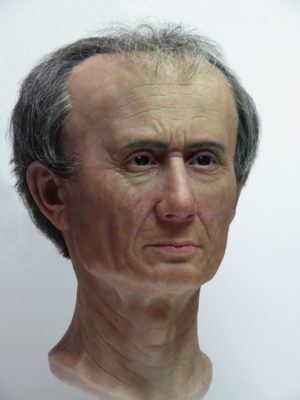
The world-renowned general Julius Caesar may have been rather less heroic than we imagine, in terms of victories as well as physique. Caesar was largely bald and had a deformed skull, resulting from difficulties during his birth. As for military campaigns, he suffered his greatest defeat in the Low Countries, possibly near the Dutch city of Maastricht, according to new research suggesting that he fought a substantial proportion of the Gallic Wars in the northern part of Gaul. These findings emerged from the research conducted by the archaeologist and author Tom Buijtendorp on Caesar’s activities in the Low Countries, in response to mounting clues for his presence here. Buijtendorp’s research was recently published in the book, Caesar in de Lage Landen (Caesar in the Low Countries). His findings about Caesar’s countenance in combination with one of the oldest portraits of Caesar from the collection of the Dutch national museum of antiquities (the Rijksmuseum van Oudheden in Leiden), were the basis for an alternative ’new’ face. The reconstruction of this face is currently on show in the museum.
The face of Julius Caesar
Recently, on 22 June 2018, a lifelike interpretation of the general’s ‘new’ face was presented at the Rijksmuseum van Oudheden, in which the asymmetric shape of the skull and the receding hairline differ significantly from the traditional images. According to Buijtendorp, Caesar’s head displays clear signs of a difficult birth – a new fact in Caesar’s biography. The specific skull abnormality enabled Buijtendorp to identify the so-called Tusculum bust (Museo Archeologico, Turin) as the most authentic portrait of Caesar, which differs markedly from the marble posthumous busts that are most commonly displayed, and fits well with the Caesar contemporary coin portrait.
Subsequently archaeologist and physical anthropologist Maja d’Hollosy was asked to make an alternative, more lifelike “Caesar of the Low Countries”, so to speak, based on one of the Caesar portraits from the collection in Leiden. Sources as the Tusculum bust and the coin portrait were used to add the missing features. Furthermore, Buijtendorp’s research gave instructions about skin, eye color and hair. The result is a mix between the three sources, with the museum bust as base. Since 100 percent reliable sources were lacking, a major aim was to make Caesar more alive, not to creat the ultimate Ceasar bust. According to Buijtendorp, this reconstruction of Caesar’s portrait reminds us that the traditional image of Caesar is unrealistic, but also shows the remaining uncertainties about details like the eyes: ‘Though the new version likewise does not represent an absolute truth, it does provide a more credible alternative to the existing picture, rejecting the symmetric head and hair image we got used to’.
The reconstruction was made possible by financial support from the Dutch province of South Holland.
A less heroic Caesar
The reconstruction of Caesar’s appearance symbolizes that we have to reconsider Caesar’s image in a wide sense. His own statistics on killed Roman soldiers suggest that roughly half of these deaths took place in the north, in Gallia Belgica. In this harsh northern region Caesar encountered his largest defeat ever, and faced a second defeat at the same place the year after. The northern military effort was so burdensome that Caesar had to limit his British ambition. Caesar’s idea of the Rhine as natural border would impact the strategy of the Roman Empire for a long time.
Buijtendorp’s research for his book ‘Caesar in de Lage Landen’ (Caesar in the Low Countries) was based in part on recently-excavated Caesarian camps, an analysis of indigenous gold coins, geographical analyses, and a renewed assessment of Caesar’s own statistics. The findings for example suggests that a hilltop stronghold near Maastricht may have served in 54 and 53 BC as the camp and logistics center of Caesar’s army, site of his largest loss. This is indicated, for instance, by a detailed analysis of gold coins and the camp’s size, which was recently established. Caesar’s description of the battle site fits quite well with the environment. In addition, the site becomes a logical choice when looking at the reconstruction of Caesar’s northern campaign. And new insights in the possible location of other camps also provide a possible match. This new perspective generates a working hypothesis that may help to actually discover archaeological remains and protect sites. The recently recognized unique shape of the hobnails in the boots of Caesar’s soldiers, since 2010 enabled researchers to link three northern camps to Caesar. New discoveries may follow, for which the book – which is written in the manner of a travel guide – identifies several possible sites. This remains challenging for marching camps. A large excavation at Limburg-Eschhofen only revealed three hobnails, while at Hermeskeil a gate probably used for several months was a special hobnail find spot. Mauchamp with clear old traces of Caesars’ large camp, did not provide related finds lacking sizeable modern excavations.
Much work lies ahead
Buijtendorp emphasises that his research is only the beginning. “Given the growing fund of clues for Caesar’s presence in the Low Countries, new work lies ahead. The research presented here will hopefully serve as a basis for further studies to test various hypotheses, as much remains uncertain.”
______________________________

New face of Julius Caesar. Reconstruction and photo by Maja D’Hollosy
______________________________
Article Source: Rijksmuseum van Oudheden news release
Tom Buijtendorp, Caesar in de Lage Landen: De Gallische Oorlog langs Rijn en Maas (in Dutch) paperback, 384 pages, ill., €25., ISBN 9789401913898, www.omniboek.nl




